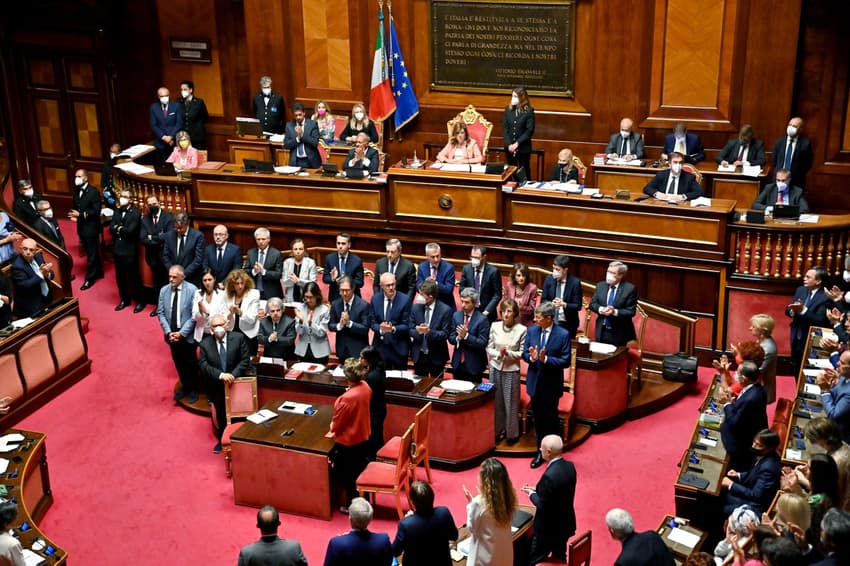TIMELINE: What happens next in Italy’s government crisis?

Prime Minister Mario Draghi has resigned, meaning the collapse of another Italian government. So what happens now?
The end finally came for Italy's faltering coalition government on Wednesday, after three of the biggest parties sat out a key confidence vote in Prime Minister Mario Draghi.
READ ALSO: Why has Italy’s government collapsed in the middle of summer?
Draghi resigned on Thursday morning, marking the end of his 'unity' government, and President Sergio Mattarella dissolved parliament later that same day. Elections will now be held in early autumn.
So what does this mean for the country now?
Draghi caretaker government: July - late September
On Thursday Draghi handed in his resignation to Italian head of state President Sergio Mattarella for the second time in the space of a week - and this time it was accepted.
Draghi will now remain in place in a caretaker role with limited powers until autumn elections.
He won't be able to draft bills or approve legislative decrees except for when deadlines are imminently approaching, as is the case for Italy's pandemic recovery plan (Piano Nazionale di Ripresa e Resilienza, or PNRR).
Early elections: September 25th (probably)
The Italian constitution states that elections must be held within 70 days of parliament being dissolved.
In the past, elections have always taken place in the 60-70 day window, to allow enough time for parties to campaign and for some would-be candidates to gather the requisite number of signatures to join the ballot.
That means that elections would be most likely to happen no earlier than Sunday September 25th, which coincides with the Jewish holiday Rosh Hashanah. This is a rarity, as Italy usually tries to avoid holding elections on religious holidays.
New government: October/November/December??
It can take weeks or even months for Italy to form a government after elections are over.
In 2018, it took 90 days for the Conte I government to be sworn in after the March 4th vote, notes news agency Ansa; in 2013, it took Enrico Letta's coalition government 63 days.
In this case it's likely to be quicker, as the so-called 'centre-right' (in reality, mostly hard-right) coalition of Brothers of Italy, Lega and Forza Italia are expected to be the clear winners, without the need to negotiate with other parties to form a majority.
Even when centre-right won a clear majority in 2008, though, it still took 25 days to form a government.
Comments
See Also
The end finally came for Italy's faltering coalition government on Wednesday, after three of the biggest parties sat out a key confidence vote in Prime Minister Mario Draghi.
READ ALSO: Why has Italy’s government collapsed in the middle of summer?
Draghi resigned on Thursday morning, marking the end of his 'unity' government, and President Sergio Mattarella dissolved parliament later that same day. Elections will now be held in early autumn.
So what does this mean for the country now?
Draghi caretaker government: July - late September
On Thursday Draghi handed in his resignation to Italian head of state President Sergio Mattarella for the second time in the space of a week - and this time it was accepted.
Draghi will now remain in place in a caretaker role with limited powers until autumn elections.
He won't be able to draft bills or approve legislative decrees except for when deadlines are imminently approaching, as is the case for Italy's pandemic recovery plan (Piano Nazionale di Ripresa e Resilienza, or PNRR).
Early elections: September 25th (probably)
The Italian constitution states that elections must be held within 70 days of parliament being dissolved.
In the past, elections have always taken place in the 60-70 day window, to allow enough time for parties to campaign and for some would-be candidates to gather the requisite number of signatures to join the ballot.
That means that elections would be most likely to happen no earlier than Sunday September 25th, which coincides with the Jewish holiday Rosh Hashanah. This is a rarity, as Italy usually tries to avoid holding elections on religious holidays.
New government: October/November/December??
It can take weeks or even months for Italy to form a government after elections are over.
In 2018, it took 90 days for the Conte I government to be sworn in after the March 4th vote, notes news agency Ansa; in 2013, it took Enrico Letta's coalition government 63 days.
In this case it's likely to be quicker, as the so-called 'centre-right' (in reality, mostly hard-right) coalition of Brothers of Italy, Lega and Forza Italia are expected to be the clear winners, without the need to negotiate with other parties to form a majority.
Even when centre-right won a clear majority in 2008, though, it still took 25 days to form a government.
Join the conversation in our comments section below. Share your own views and experience and if you have a question or suggestion for our journalists then email us at [email protected].
Please keep comments civil, constructive and on topic – and make sure to read our terms of use before getting involved.
Please log in here to leave a comment.